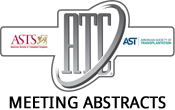2015 American Transplant Congress
Pancreas Transplant Sera Improves the Function and Proliferation of Endothelial Cells
Transplant Services, Allegheny General Hospital, Pittsburgh, PA.
Pancreas transplantation (Tx) allows for the study of diabetes by examining the reversal of the disease. Previously, we observed that after pancreas Tx many patients'…2015 American Transplant Congress
Increased Vascular Stiffness in Pediatric Renal Transplant Recipients Despite Normal Kidney Function, Blood Pressure, and Body Mass Index
1Southern Illinois University, Springfield, IL; 2Washington University, St. Louis, MO.
Background: Chronic kidney disease (CKD) imparts enormous cardiovascular (CV) risk that is only partially improved by renal transplantation. We sought to understand the determinants of…2015 American Transplant Congress
Lymphatic Endothelium Uniquely Enhances T Cell Migration to S1P
University of Maryland, Baltimore, MD.
Introduction: Sphingosine-1-phosphate (S1P) is a signaling sphingolipid that regulates cell egress from lymphoid and non-lymphoid tissues. While S1P has been described as a chemoattractant, its…2015 American Transplant Congress
Tandem P-Selectin Glycoprotein Ligand-Immunoglobulin (TSGL-Ig) Protects Liver Endothelial Cells Against Prolonged Cold Preservation Injury in Mouse Liver Transplantation
Background: Liver endothelial cell (LEC) damage is central in the pathogenesis of hepatic ischemia-reperfusion injury (IRI). LEC detachment/progressed denudation are typical during cold storage and…2015 American Transplant Congress
Allogeneic Monocyte–Endothelial Cell Interaction Plays a Critical Role in Initiating Early Pro-Fibrosis Responses
Surgery, Duke University Medical Center, Durham, NC.
Chronic allograft nephropathy (CAN), characterized by interstitial fibrosis, vascular intimal thickening, and glomerulosclerosis, has remained as leading cause of allograft failure. The role of innate…2015 American Transplant Congress
Lymphotoxin Controls Treg Interactions With Lymphatic Endothelial Cells and Interstitial Migration In Vivo
University of Maryland, Baltimore, MD.
Introduction: Lymphotoxin (LT) coordinates the development, organization and structure of lymphoid organs, and LTβreceptor (LTβR) is involved in thymocyte migration. However, LT has no described…2015 American Transplant Congress
Monocyte Recruitment to HLA Class I Antibody-Activated Endothelial Cells Is Dependent Upon mTOR
Pathology & Laboratory Medicine, UCLA, Los Angeles, CA.
Aim: Antibody-mediated rejection (AMR) persists as a major issue affecting solid organ transplants. The purpose of this study was to investigate the proximal signaling events…
- « Previous Page
- 1
- …
- 16
- 17
- 18
